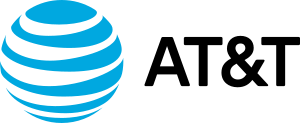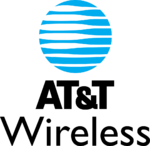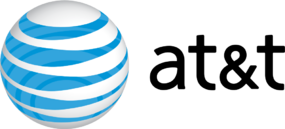- This page was last modified on 17 October 2025, at 10:18. Suggest an edit.
AT&T Mobility facts for kids
This page is about the telecommunications company owned by AT&T that is marketed with the same name. For AT&T itself, see AT&T.
 |
|

AT&T Mobility headquarters in the Lenox Park district of Brookhaven, Georgia, adjacent to Atlanta
|
|
|
Formerly
|
Cingular Wireless, LLC (2000-2006) |
|---|---|
| Subsidiary | |
| Industry | Telecommunications |
| Founded | April 2000 (as Cingular Wireless) December 29, 2006 (as AT&T Mobility) |
| Headquarters |
Lenox Park, Brookhaven, Georgia
,
United States
|
|
Number of locations
|
5,000 retail stores; 2,300 owned 1,500 authorized 1,950 Prime Communications |
|
Area served
|
United States FirstNet Only Puerto Rico & U.S. Virgin Islands |
|
Key people
|
David Christopher (president) |
| Products | Mobile telephony Wireless broadband |
|
Number of employees
|
75,000 (2015) |
| Parent | AT&T Communications |
| Divisions | Cricket Wireless |
AT&T Mobility, also known as AT&T Wireless, is a big American company. It provides wireless phone services across the United States. It started in April 2000 as Cingular Wireless. Today, it is part of AT&T Inc.. AT&T Mobility is one of the largest wireless companies in the U.S. It had 118.2 million customers by June 2025.
The company's main office is in Brookhaven, Georgia. Cingular Wireless was first a joint project between SBC Communications and BellSouth. In 2004, Cingular bought the older AT&T Wireless Services. Later, SBC bought the original AT&T company and took its name. Cingular became fully owned by AT&T in December 2006. This happened when AT&T bought BellSouth.
In January 2007, Cingular announced it would change its name to AT&T. Both names were used for a while during the change. The switch was finished in June 2007. This was just before the first Apple iPhone was released.
In March 2011, AT&T Mobility planned to buy T-Mobile US. This deal was worth $39 billion. If it had happened, AT&T would have had over 130 million customers. But the U.S. government and other companies did not agree. They worried it would reduce competition in the phone market. So, in December 2011, AT&T stopped its plan to buy T-Mobile.
Contents
What AT&T Mobility Offers
AT&T has different phone plans for its customers. These include "Unlimited Your Way" plans like Premium PL, Extra EL, or Starter SL. Customers can also pick the "Value Plus VL" or "4 GB" plans.
All plans come with unlimited talking and texting. Most plans also have unlimited data. The higher-level plans offer "premium data" for better service. They also include features like Mobile Hotspot. The Unlimited Premium® PL plan even has unlimited talk, text, and data in 20 Latin American countries.
Since January 2016, AT&T no longer offers two-year contracts for new smartphones. Customers now use AT&T's "NEXT" installment plans. This means they pay for their phone over time.
AT&T stores also offer other services. These include home phone, internet, and U-verse in some areas. All AT&T stores sell DirecTV services. AT&T also gives free email services to its customers.
AT&T Mobility Employees
Many AT&T Mobility employees are part of a union. This union is called the Communications Workers of America (CWA). In 2006, the CWA represented about 15,000 AT&T Wireless employees. By the end of 2009, the union said it represented about 40,000 AT&T Mobility workers.
How AT&T Mobility Started
Cingular Wireless Begins
Cingular Wireless was a company that offered wireless phone services. It started in April 2000. It was a joint project between SBC Communications and BellSouth. This partnership made Cingular the second-largest phone company in the U.S.
Cingular grew from over 100 smaller companies. Many of these had roots in the old "Bell" phone system. Some of these companies included:
- Ameritech Mobile Communications
- BellSouth Mobility
- Southwestern Bell Mobile Systems
- Pacific Bell Wireless
- SNET Mobility
Cingular's history goes back to Advanced Mobile Phone Service (AMPS). AMPS was a part of AT&T that offered cellular service. When the Bell System split up, AMPS was divided among different regional phone companies.
In October 2007, Stan Sigman, the president of AT&T, retired. Ralph de la Vega became the new president and CEO of AT&T Mobility.
Joining with AT&T Wireless
In February 2004, Cingular decided to buy another company. It bought AT&T Wireless Services for $41 billion. This was a very large amount of money.
The deal was completed on October 26, 2004. After this, Cingular became the largest wireless provider in the U.S. It had 46 million customers. AT&T Wireless was then renamed "New Cingular Wireless Services." Soon after, commercials showed the AT&T logo changing into the Cingular logo.
At the time of the merger, there were two separate networks. These were the AT&T "Blue" Network and the Cingular "Orange" Network. Both networks used different technologies. About 50,000 cell towers had to be combined. The "blue" and "orange" networks were considered separate until they were fully joined in 2005.
The New AT&T Brand
On November 21, 2005, Edward Whitacre Jr., the CEO of the new SBC/AT&T, announced plans. He wanted to market Cingular's service under the AT&T name.
Then, on March 5, 2006, AT&T announced it would merge with BellSouth. This deal was finalized on December 29, 2006. The next month, AT&T said it would stop using the Cingular brand. All services would be called AT&T. They launched an advertising campaign called "The New AT&T." The commercials showed the orange Cingular logo changing into the AT&T globe logo. AT&T even added the color orange to its signs to show the change.
In November 2007, AT&T merged with Dobson Communications. Dobson owned Cellular One and was a partner of AT&T. This deal added 1.7 million customers. It also expanded AT&T's coverage in many areas. In November 2008, AT&T bought Centennial Wireless. This expanded its coverage in the Midwest, southern U.S., and Puerto Rico.
Attempt to Buy T-Mobile USA
On March 20, 2011, AT&T and Deutsche Telekom announced a big plan. AT&T wanted to buy T-Mobile USA for about $39 billion. AT&T hoped the deal would close in 12 months. But it needed approval from the government.
The U.S. Department of Justice and the Federal Communications Commission (FCC) looked into the deal. Other companies like Sprint Corporation also opposed it. They worried it would make the phone market less competitive. On August 31, 2011, the Justice Department filed a lawsuit to stop the merger.
Facing strong opposition, AT&T withdrew its offer in November 2011. They also had to pay a $3 billion fee and transfer $1 billion worth of spectrum to T-Mobile.
Recent Years (2012-Present)
On August 2, 2012, AT&T announced plans to buy NextWave Wireless. In January 2013, AT&T also planned to buy the U.S. wireless operations of Atlantic Tele-Network, known as Alltel. In June 2014, AT&T bought assets from Plateau Wireless. This included wireless spectrum and 40,000 customers in New Mexico and Texas.
In 2014 and 2015, AT&T bought Mexican wireless companies Iusacell and Nextel Mexico. These became AT&T Mexico.
In October 2019, Liberty Cablevision of Puerto Rico bought AT&T Wireless Services in Puerto Rico and the U.S. Virgin Islands. This deal was for $1.95 billion. The sale was completed in November 2020. By September 2021, Liberty started to change the brand from AT&T to its own.
On February 22, 2024, a large outage affected AT&T customers across the country.
AT&T's Network
AT&T has a very large digital voice and data network in the United States. It is the second-largest network. AT&T's network supports 4G and uses LTE for calls and data. AT&T is also building out its 5G network.
Cingular, AT&T's older company, used older networks like TDMA and analog. These older networks were shut down by February 2008.
In 2002, Cingular started "Project Genesis." This project added GPRS to the entire wireless network. By 2004, this project was finished. Later, the network was updated to EDGE.
In 2005, AT&T launched a faster network called "BroadbandConnect." This network used UMTS and HSDPA technology. It was launched in many major cities. By the end of 2006, it was in all major cities. By early 2009, AT&T Mobility had updated its 3G network to HSUPA.
In 2011, AT&T updated its network to HSPA+. They marketed this as offering "4G" speeds. On September 18, 2011, AT&T launched LTE service in 5 U.S. cities. They planned to have it in 15 cities by the end of the year. By November 2012, AT&T's LTE network served 150 million users.
On January 1, 2017, AT&T stopped using its 2G GSM network.
In April 2017, AT&T announced upgrades to its LTE networks. These upgrades were called "5G Evolution" (5G E).
In January 2018, AT&T said it would launch 5G NR service by the end of the year.
On February 22, 2022, AT&T stopped using its 3G UMTS network.
Today, AT&T operates the second-largest 5G network in the U.S. It covers about 30% of the country. AT&T uses different types of frequencies for 5G. Mid and high-band 5G is called "5G+" and offers much faster speeds. AT&T plans to cover 200 million people with 5G+ by the end of 2023.
Marketing and Products
Fewest Dropped Calls Campaign
In 2006, Cingular started advertising that it had the "Fewest dropped calls." They used information from a company called Telephia. Telephia said Cingular had fewer dropped calls than other companies.
However, other reports disagreed. Consumer Reports and J.D. Power and Associates ranked Cingular lower. Telephia later said Cingular should not have used their name in advertising. AT&T stopped saying "The Fewest Dropped Calls" directly. But they continued to show ads about not dropping calls.
The iPhone
On June 29, 2007, Apple launched the iPhone in the United States. AT&T was the only company that offered the iPhone in the U.S. until February 2011. Then, the iPhone 4 also became available on the Verizon network.
When the iPhone first came out, some customers had issues with their phone bills. One famous example was a 300-page iPhone bill. This was shown in an online video by YouTube creator iJustine.
Apple launched the iPhone 3G with AT&T on July 11, 2008. Over 1 million iPhone 3G devices were sold in the first three days. This was much faster than the first iPhone. In August 2008, Best Buy also started selling the iPhone 3G for AT&T.
The iPhone 4 was released on June 24, 2010. Apple sold over 1.7 million iPhone 4 units in the first few days. This was the most sales for any phone at that time. These sales helped AT&T have strong results.
The iPhone 5 was released on September 12, 2012. Apple reported selling 5 million iPhone 5s in the first weekend. AT&T activated 8.5 million iPhones in late 2012.
Android Phones
On February 18, 2010, AT&T announced its first phone using Google's Android system. This was the Motorola Backflip, released in March 2010.
Other Android phones followed, like the HTC Aria and the Samsung Captivate. The Samsung Captivate was part of the Galaxy S family. Motorola also made several Android phones for AT&T.
At first, AT&T did not allow users to install apps from outside the official app store on Android phones. But in May 2011, AT&T changed this rule. They announced that some Android devices would allow installing unofficial apps.
4G LTE Advertising
In November 2012, AT&T started a new advertising campaign for its 4G and 4G LTE networks. These commercials featured Beck Bennett interviewing children. The slogan was "It's not complicated." The children were asked simple questions like if fast or slow is better.
In Need for Speed Games
In the video games Need for Speed: Underground 2 and Need for Speed: Carbon, Cingular was shown as the mobile internet provider. This was seen in the in-game messages.
Other AT&T Services and Brands
AT&T Prepaid
AT&T Prepaid (also called AT&T PREPAID) is a service where you pay for your phone service before you use it. It used to be called GoPhone.
The GoPhone name was first used in 1987 by McCaw Cellular. AT&T bought McCaw Cellular in 1995. The name was then used by the old AT&T Wireless. After Cingular bought AT&T Wireless in 2004, Cingular used the GoPhone name for its prepaid services. The GoPhone brand was still used even after Cingular became AT&T Mobility. In 2017, it was rebranded as AT&T PREPAID.
By January 2019, AT&T Prepaid had 6 million customers.
NumberSync
NumberSync was launched in 2015. This service lets AT&T customers use one phone number for calls and texts. They can use it across all their supported devices, like smartwatches or tablets.
Other Companies Part of AT&T
- AT&T Prepaid (formerly AT&T GoPhone)
- Cricket Wireless
- AT&T Mexico




